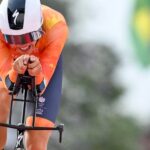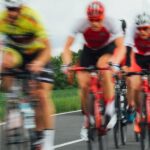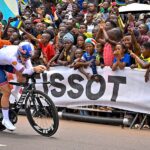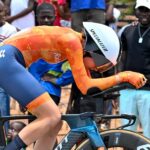
Bike breakdowns and gear choices often grab attention in bikepacking and ultra-distance races — but nutrition is what truly carries riders to the finish. As a sports dietitian and first-time participant in the Trans North Georgia Adventure (TNGA), a 350+ mile self-supported race with nearly 40,000 feet of climbing, I set out to test my fueling strategy. By blending data-driven estimates with real-world adjustments, I explored how to balance energy demands of 9–11 hour days in the saddle with the realities of heat, terrain, and fatigue. This first part of my TNGA Bonk Breakdown covers how I prepared my nutrition plan and what I learned along the way.

Riders and spectators love to ogle over tech, custom gear, and different approaches — sometimes out of curiosity, sometimes from fear of forgetting something or over-packing. But in ultra-distance events, it’s not just the equipment that carries riders — it’s nutrition. I recently tackled the Trans North Georgia Adventure (TNGA), a self-supported 350+ mile race with nearly 40,000 feet of climbing and 100 miles of singletrack.
As a sports dietitian and first-time TNGA rider (not racing… though the lines got blurred at times), I wanted to see how both rookies and veterans fueled the effort. I surveyed riders and also tracked my own nutrition to learn from the experience. In part one of this “TNGA Bonk Breakdown,” I’ll cover my nutrition preparation. In part two, I’ll dive into what I packed, how I ate, and how others approached their fueling.
My Approach
I’ll admit it — I’m green in the bikepacking world. My setup, equipment, and know-how were just enough to get me through. Most of my racing background comes from road and marathon MTB events. But as a dietitian, energy demands and nutrition are my jam, so I knew I could lean on that knowledge if I prepare just right. So my first question was: how should I fuel this thing?
Goal time: 4–5 days, 9–11 hours of riding per day. Enough to challenge me, but not so much that I’d be sleep-deprived or unable to enjoy the experience.
Estimating Needs
Using past body comp data, indirect calorimetry, DXA scans, and other formulas, I estimated my Basal Metabolic Rate (BMR) at ~1850 kcal/day. Adding a bit for daily movement off the bike, I rounded to ~2050 kcal/day without exercise.
From power data, I estimated 500–700 kcal/hour at an endurance pace. Multiplying by Strava’s predicted times for each stage gave me ~7700–8600 kcal/day total. That’s a lot of food.
As a dietitian, I like using ranges since estimates always carry uncertainty. I added two more approaches: metabolic scope and a minimum replacement percentage.

Metabolic Scope
Metabolic scope describes energy expenditure as a multiple of BMR the human body can sustain for a period of time. Estimates range from 2.5 to 9+. For me, that range would be 4600–16,000 kcal/day. Quite the range, but interestingly the same phenomenon we have with power-duration curves for cyclists – intensity decreasing over time – applies to energy expenditure as well. In fact there’s a theoretical energy expenditure over duration curve (1).

Adapted Image using AI based on (1)
Examples:
- Ironman triathlon (11 hours): metabolic scope ~9.4
- Race Across America (multi-day): ~2.5
- Tour de France:
Given TNGA’s steady but long days, I used ~4x BMR as my ceiling → ~8200 kcal/day. Granted I’m not riding the Tour, and I’m not doing an intense 4-6 hour, but rather a steady 9-11 hours, this looked right, even if that’s not precise using a bit of intuition is sometimes needed when venturing into the unknown.
Minimum Energy Needs
If 8200 kcal was the ceiling, what then was the floor? Data from Race Across America and Tour de France Femmes suggest athletes can complete long duration events on 70–75% of energy replacement (2,3). Although this is far from ideal and not recommended, I decided this could be my “floor” for intake, which was around 5600–6500 kcal/day. There are case studies of a 24-Hour MTB racer racking up a 10,000 kcal deficit, since I needed to start the next day I did my best to avoid anything of that sort (4).
So my three total energy expenditure estimates looked like this:
- Percentage-based minimum: 5600–6500 kcal
- Power-based estimate: 7700–8600 kcal
- Metabolic scope max: 8200 kcal
Was this line of thinking overkill? Probably. But having a plan can be useful — even if you know it’s bound to change once you’re on route (and it did).
What Actually Happened
I didn’t have a power meter (sadly), but I was able to track my heart rate and pace. Of note, I originally planned to ride TNGA then bike another 65–70 miles home. But after saddle sores and brutal heat, I called it early — finishing Tuesday night instead of Wednesday afternoon, completing the route, but calling my wife for a ride home instead of continuing to ride back. Also of note, on day one I stopped 10 miles short, cooked from the heat. Making up those miles the next day took nearly three hours on some of the hardest singletrack, which made day two longer than anticipated.
Still, the numbers lined up reasonably well:

Summary Totals
- Predicted Expenditure = 36,900 kcal
- Actual Expenditure (HR & Pace) = 31,150 kcal
- Actual Intake (Food Log) = 27,263 kcal
- Estimated Deficit = 3,887 kcal
Given I finished a day early and felt strong in the second half, I’d say my plan worked. The intake numbers were off, but not catastrophic and within range. Underfueling was more of a rest and refuel error than anything, and once the predicted total expenditure is adjusted to account for 8 hours less riding and one less night of sleep, things were pretty close. But as you’ll see in part two, the day-to-day energy management wasn’t quite as clean.

References
- Thurber, C., Dugas, L. R., Ocobock, C., Carlson, B., Speakman, J. R., & Pontzer, H. (2019). Extreme events reveal an alimentary limit on sustained maximal human energy expenditure. Science advances, 5(6), eaaw0341. https://doi.org/10.1126/sciadv.aaw0341
- Hulton, A. T., Lahart, I., Williams, K. L., Godfrey, R., Charlesworth, S., Wilson, M., Pedlar, C., & Whyte, G. (2010). Energy expenditure in the Race Across America (RAAM). International journal of sports medicine, 31(7), 463–467. https://doi.org/10.1055/s-0030-1251992
- Areta, J. L., Meehan, E., Howe, G., & Redman, L. M. (2024). Energetics of a World-Tour Female Road Cyclist During a Multistage Race (Tour de France Femmes). International journal of sport nutrition and exercise metabolism, 34(5), 253–257. https://doi.org/10.1123/ijsnem.2023-0275
- Bescós, R., Rodríguez, F. A., Iglesias, X., Benítez, A., Marina, M., Padullés, J. M., Torrado, P., Vázquez, J., & Knechtle, B. (2012). High energy deficit in an ultraendurance athlete in a 24-hour ultracycling race. Proceedings (Baylor University. Medical Center), 25(2), 124–128. https://doi.org/10.1080/08998280.2012.11928806
The post Fueling the Trans North Georgia Adventure: A Sports Dietitian’s Nutrition Strategy for Ultra-Distance Bikepacking appeared first on PezCycling News.





